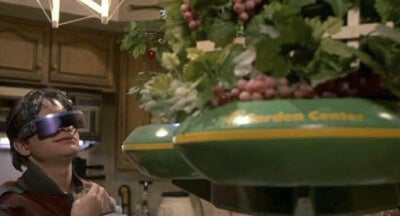26 years ago, Marty McFly and Doc Brown climbed into their time-traveling flying DeLorean and set the controls to the distant future — October 21, 2015 — which happens to be this week.
This is a fun post about the predictions that Back to the Future got right, the predictions they got wrong, and the amazing technologies we have today that they just completely left out.
For a $40 million budget, it’s pretty amazing what they achieved. So as you read these correct predictions, think about how you might have profited from these areas if you took action on them 26 years ago.
Here Are the Predictions ‘Back to the Future’ Got Right
Here’s a short list of the stuff they got right (26 years ago!):
1. Brain controlled/wireless video games

2. 3D movies

3. Handheld tablet computers

4. Videoconferencing (e.g., Marty videoconferences with his coworker Needles)
5. Augmented and virtual reality wearable technology

6. Wall-mounted widescreen TVs with multiple TV channels viewed simultaneously
7. Hydroponics

8. Biometric scanners—fingerprint scanners as door locks and for payment (e.g., “thumbing” to pay for a taxi fare)
Predictions ‘Back to the Future’ Got Wrong
Here are the technologies that aren’t quite here (yet).
- Flying cars: While there are a number of companies like Zee.aero, Terrafugia and AeroMobil hard at work, this still may need an XPRIZE to give us the flying car.
- Power clothing (self drying, self tying shoelaces): While not released, Nike claims to be releasing a pair of self-tying laces this year (2015) in commemoration of the movie.
- Ubiquitous fax machines: For whatever reason, fax machines were a big deal in Back to the Future… They are basically a relic of the past now.
- Hoverboards: Though a few companies have rigged gigantic magnets to simulate real life hoverboards, we haven’t found a way to make a practical, scalable version yet…
- Mr. Fusion: While many teams are claiming to be close to net-positive energy fusion, no one has reached it… and even when they do, it’s unlikely to fit in the back of my car.
- Well… a time machine: Though I wish we could all drive DeLoreans rigged with time machines, unfortunately, the laws of physics still prevent us from jumping around the space-time continuum at will.
A Few Amazing Things We Have Today, That They Missed
So what did Back to the Future (potentially) miss? At least, what amazing technology do we have today that they didn’t highlight?
- Rapid, cheap whole genome sequencing and editing: We now have the ability to sequence a full human genome for under $1,000. The technology is developing at 3x the rate of Moore’s Law. We now have the ability to cheaply and precisely edit the genome with CRISPR/CAS 9. This will open up a new frontier of health and longevity that will have enormous implications on the future.
- 3D Printing: You can 3D print just about anything these days from 300 different materials — plastics, metals, concrete, chocolates, human cells. Complexity is free and scalability is inherent.
- Emergence of AI: We are in the early days of artificial intelligence. Tens of billions in capital are being poured into an AI “arms race” over the last decade. One fun recent example is Tesla’s “autopilot” software upgrade that just came out — their AI can drive you autonomously on the highway.
- On-Demand Economy: Amazon is working on same-day delivery mechanisms (possibly using drones). Uber has become ubiquitous as the simplest, most reliable way to get around.
- GPS: We really take for granted how good the GPS units in our phones really are. They receive up-to-the-second traffic data, route us to the shortest path, and even give us “street view” or satellite imagery to investigate what a place looks like before we get there.
- Private Spaceflight and Hyperloop: While Back to the Future flaunted flying DeLoreans, I’m proud of where we are with private spaceflight and the start of Hyperloop.
Image Credit: Oto Godfrey/Wikimedia Commons (banner); Back to the Future Part II



